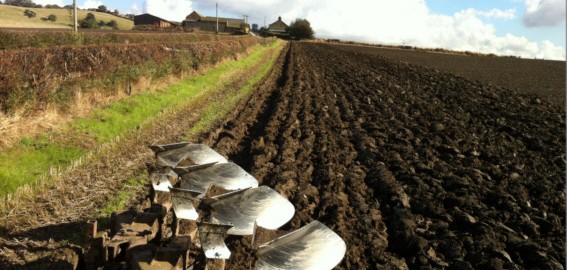Large amounts of rainfall this summer have left most pastures vulnerable to soil compaction. Evidence for this has been very clear, with fields poached up from livestock, and deep ruts prevalent after silage time. So why soil aeration is important, do we need it and what is the most cost effective method of doing it?
The vast majority of soil life requires oxygen to release energy from sources of organic carbon, a bit like a fire needs air to burn and release heat. Plants are the main source of organic carbon in the soil. They take carbon dioxide out of the air during photosynthesis, and use the energy from the sun to turn the carbon, of carbon dioxide it into carbohydrate. These carbohydrates are stored in the plant roots. When this energy is needed by the plant to grow, oxygen is required to release it from the root.
Micro-organisms are the soil life, they too require oxygen to break down and use waste plant carbohydrates and dead plants and animals. Micro-organisms are responsible for the cycling and release of nutrients (including nitrogen), the breakdown of manure and the maintenance of optimum physical soil conditions. They enable soils to be more robust, better able to cope with droughts, floods, and changes in nutrient availability.
In the top foot of soil, it’s estimated that there are 2 tonnes of soil life per acre. This then tells us that greatest need for oxygen is near the soil surface where there are the maximum number of roots, micro-organisms, and other animals. Air travels in and out of soil passively, through holes and cracks. Compaction reduces the movement of air into the soil and so it limits the nutrient release from the soil. When soil is water logged, as can easily happen on compacted ground, air movement can be reduced by 82%. In soils without enough air, plant and soil life are unable to access energy reserves and the cycle and release of valuable nutrients is slowed. Substances are produced in the soils that inhibit root growth, and nitrogen is lost from the soil as gas. This is easily seen by poor grass growth in compacted areas.
As mentioned in previous newsletters the best way to assess compaction is to dig an 8 inch square hole by a foot deep. Try to remove this in one piece and lay it next to your hole. Ideally the top 2 inches should have a nice crumbly structure, the next 2 inches should be half crumbly, and below this the remaining soil should have around 10% crumb texture.
By doing this you can easily see where the soil is compacted, and react accordingly. Often compaction is indicated at the depth that it is hardest to push the spade into the soil. A subsoil type aerator is most useful for compaction caused by heavy machinery, deeper in the soil profile. The subsoiler lifts the soil slightly and drops it, producing cracks that run vertically down the soil profile. It is an expensive operation in terms of time and diesel and runs the risk of disturbing old drains; therefore it should only be used for deeper compaction.
Pasture spiker type aerators are becoming popular, these act in the top 4 inches of the soil allowing air to enter the soil more freely so stimulating the soil life, and plant growth, wider aerators 5m plus offer a far better work rate and so save diesel and time. Muck spreading can also alleviate light surface compaction by increasing soil life, and encouraging the earth worms and beetles to burrow through the soil, which again helps air and water move more freely through the soil. All forms of aeration work on the same principle, of increasing air passage into the soil, this then stimulates the soil life, increasing the speed at which nutrients are cycled and released in the soil, and so improving soil health and pasture growth.



